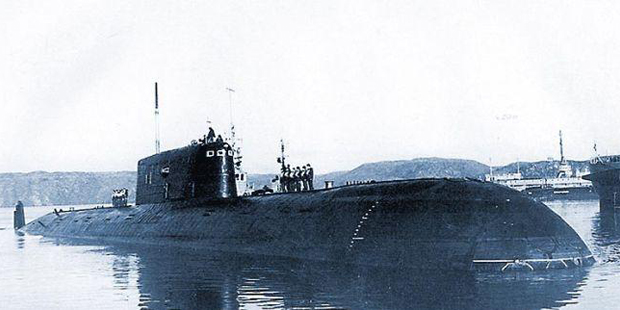
The Soviet Navy nuclear-powered attack submarine, Komsomolets, is back in the news more than thirty years after it sank off the coast of Norway. The experimental submarine is leaking radioactivity from her nuclear reactor, leading to headlines that the leak is “800,000 times” the radioactivity of the surrounding water. The leak, while ominous, is actually not that big a deal.
On April 7, 1989, the experimental attack submarine Komsomolets (above) was on patrol 200 miles north of the Norwegian mainland. Komsomolets caught fire and in the ensuing, dramatic effort to save the ship 42 of 62 crew members were killed—many after they had exited the submarine where they died of hypothermia. The submarine sank in a mile of water, along with the onboard nuclear reactor and two nuclear torpedoes carrying plutonium.
Komsomolets was named after the Soviet Union’s communist youth league. It was a prototype for submarines that could carry both torpedoes and cruise missiles, standard operating procedure for Russian submarines today. It also incorporated a double hull, with the inner hull constructed of titanium. This gave the submarine the ability to dive to depths of up to 3,000 feet, far deeper than its American counterparts. A large submarine, she displaced 8,000 tons underwater, was 400 feet long, and had a beam (width) of 27 feet.
The submarine has sat in the Norwegian Sea for 35 years, at a depth of 1,659 meters (5,442 feet). The sub exceeded the crush depth of its titanium hull but is still in one piece.
The submarine is also leaking radioactivity. Operating from the research vessel G. O. Sars, Norwegian and Russian researchers took radiation samples from a duct that had previously been sampled by Russian investigators in the 1990s and 2000s. The team used the remotely operated vehicle Ægir 6000 to take test samples of the water, discovering radioactivity escaping from the submarine at a rate of 100 to 800 becquerels per liter. That’s far higher than the radioactivity of the surrounding seawater, which was measured at .001 becquerels per liter.
A becquerel is a unit of measure of radioactivity that counts the amount of radiation released when an element such as uranium emits energy as the result of the radioactive decay (or disintegration, in the case of a nuclear explosion) of an unstable atom. The short of it: 800 becquerels is not a big deal, especially when it is in the middle of nowhere and the radioactivity is diluted into the underwater environment. The researchers believe it is not even a threat to Norwegian seafood stocks, which are a major source of food and exports for the Scandinavian country.
“The levels we detected were clearly above what is normal in the oceans, but they weren’t alarmingly high,” explained expedition leader Hilda Elise Heldal.
So, the wreck of the Komsomolets is safe…for now. If the nuclear reactor is somehow ruptured, that could cause a larger radiation leak in the future. There’s also the matter of the two nuclear-tipped torpedoes: the plutonium inside them both could outlast the containment method and spill out from the wreck. That process will likely take much longer, though scientists and engineers are studying how to fix the situation now—including lifting the entire submarine out of the water.
